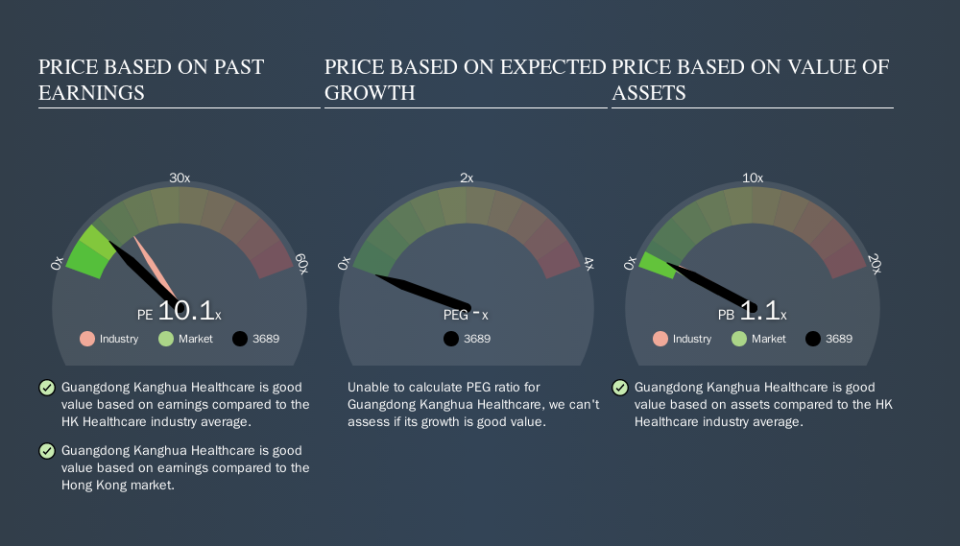Do You Know What Guangdong Kanghua Healthcare Co., Ltd.'s (HKG:3689) P/E Ratio Means?

The goal of this article is to teach you how to use price to earnings ratios (P/E ratios). We'll apply a basic P/E ratio analysis to Guangdong Kanghua Healthcare Co., Ltd.'s (HKG:3689), to help you decide if the stock is worth further research. What is Guangdong Kanghua Healthcare's P/E ratio? Well, based on the last twelve months it is 10.12. In other words, at today's prices, investors are paying HK$10.12 for every HK$1 in prior year profit.
See our latest analysis for Guangdong Kanghua Healthcare
How Do You Calculate A P/E Ratio?
The formula for P/E is:
Price to Earnings Ratio = Price per Share (in the reporting currency) ÷ Earnings per Share (EPS)
Or for Guangdong Kanghua Healthcare:
P/E of 10.12 = HK$4.54 (Note: this is the share price in the reporting currency, namely, CNY ) ÷ HK$0.45 (Based on the year to June 2019.)
Is A High Price-to-Earnings Ratio Good?
A higher P/E ratio means that buyers have to pay a higher price for each HK$1 the company has earned over the last year. That isn't a good or a bad thing on its own, but a high P/E means that buyers have a higher opinion of the business's prospects, relative to stocks with a lower P/E.
Does Guangdong Kanghua Healthcare Have A Relatively High Or Low P/E For Its Industry?
One good way to get a quick read on what market participants expect of a company is to look at its P/E ratio. If you look at the image below, you can see Guangdong Kanghua Healthcare has a lower P/E than the average (16.2) in the healthcare industry classification.
Guangdong Kanghua Healthcare's P/E tells us that market participants think it will not fare as well as its peers in the same industry. Many investors like to buy stocks when the market is pessimistic about their prospects. If you consider the stock interesting, further research is recommended. For example, I often monitor director buying and selling.
How Growth Rates Impact P/E Ratios
Companies that shrink earnings per share quickly will rapidly decrease the 'E' in the equation. Therefore, even if you pay a low multiple of earnings now, that multiple will become higher in the future. Then, a higher P/E might scare off shareholders, pushing the share price down.
Guangdong Kanghua Healthcare's earnings per share fell by 12% in the last twelve months. And over the longer term (3 years) earnings per share have decreased 1.9% annually. This growth rate might warrant a low P/E ratio.
Don't Forget: The P/E Does Not Account For Debt or Bank Deposits
It's important to note that the P/E ratio considers the market capitalization, not the enterprise value. That means it doesn't take debt or cash into account. In theory, a company can lower its future P/E ratio by using cash or debt to invest in growth.
Spending on growth might be good or bad a few years later, but the point is that the P/E ratio does not account for the option (or lack thereof).
Guangdong Kanghua Healthcare's Balance Sheet
Guangdong Kanghua Healthcare has net cash of CN¥491m. This is fairly high at 32% of its market capitalization. That might mean balance sheet strength is important to the business, but should also help push the P/E a bit higher than it would otherwise be.
The Verdict On Guangdong Kanghua Healthcare's P/E Ratio
Guangdong Kanghua Healthcare has a P/E of 10.1. That's around the same as the average in the HK market, which is 10.2. While the lack of recent growth is probably muting optimism, the net cash position means it's not surprising that expectations put the company roughly in line with the market average P/E.
Investors have an opportunity when market expectations about a stock are wrong. As value investor Benjamin Graham famously said, 'In the short run, the market is a voting machine but in the long run, it is a weighing machine. We don't have analyst forecasts, but you could get a better understanding of its growth by checking out this more detailed historical graph of earnings, revenue and cash flow.
You might be able to find a better buy than Guangdong Kanghua Healthcare. If you want a selection of possible winners, check out this free list of interesting companies that trade on a P/E below 20 (but have proven they can grow earnings).
We aim to bring you long-term focused research analysis driven by fundamental data. Note that our analysis may not factor in the latest price-sensitive company announcements or qualitative material.
If you spot an error that warrants correction, please contact the editor at editorial-team@simplywallst.com. This article by Simply Wall St is general in nature. It does not constitute a recommendation to buy or sell any stock, and does not take account of your objectives, or your financial situation. Simply Wall St has no position in the stocks mentioned. Thank you for reading.


